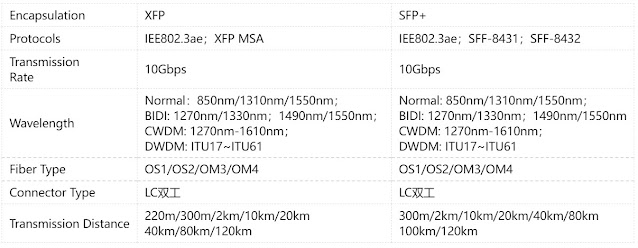What is the difference between XFP Transceivers and SFP+ Transceivers ?
Optical modules are one of the essential components for data transmission in fibre optic networks. 10G optical modules are widely used in schools, companies and other applications due to their low cost and power consumption. xfp optical modules and SFP+ optical modules are two common types of 10G optical modules, what is the difference between them? Can they communicate with each other?
XFP optical module and SFP+ optical module basic introduction
XFP is defined by the XFP Multi-Source Agreement (MSA). XFP optical module is a 10G optical module that supports hot-swappable and protocol-independent communication, and can transmit data at 850nm/1310nm/1550nm wavelengths, mainly used in 10G Ethernet, 10Gbit/s Fibre Channel, digital transmission of OC-192, synchronous optical network STM-64, 10Gbit/s Optical Transport Network (OTN) OUT-2 and parallel fibre links.
SFP+ is an upgraded version of SFP, defined by the SFP+ Multi-Source Agreement (MSA), the SFP+ optical module is a small, hot-swappable 10G optical module that follows IEEE 802.3ae, SFF-8431 and SFF-8432 protocols and can operate at 850nm/1310nm/1550nm wavelengths for applications such as 10G Ethernet, 10G fibre channel, 10G SONET/SDH, OTN, CPRI wireless, 16G Fibre Channel and 32G Fibre Channel.
The difference between XFP optical modules and SFP+ optical modules
The following table shows the basic parameters of 10G XFP optical modules compared to 10G SFP+ optical modules.
Size & Heat Dissipation: XFP optical modules are larger than SFP+ optical modules, but dissipate heat better.
Construction: Unlike XFP optical modules, SFP+ optical modules have the signal modulation function, serial/deserialiser, MAC, clock and data recovery (CDR) and electronic dispersion compensation (EDC) functions on the motherboard rather than on the module.
Compatibility: Firstly, it is clear from the above that the two do not have the same dimensions and therefore they are not compatible. Secondly, SFP+ ports can support both SFP optical modules and SFP+ optical modules with some compatibility, but only XFP optical modules can be supported on XFP ports.
Cost: 10G SFP+ optical modules cost less than 10G XFP optical modules and are interoperable with other types of 10G optical modules.
Popularity: As can be seen above, SFP+ has greater advantages over XFP in terms of size, structure, compatibility and cost, meeting user requirements for high density, low cost and scalability, and has become the mainstream of the 10G market.
Can XFP optical modules be replaced br SFP+ optical modules?
As XFP and SFP+ optical modules have the same transmission rate (both 10Gbps) and wavelength (850nm/1310nm/1550nm), they can co-exist in the same Ethernet network. This means that XFP optical modules and SFP+ optical modules can be connected to each other as long as they have the same parameters, for example, a 10G XFP optical module with a wavelength of 1310nm and a 10G SFP+ optical module with a wavelength of 1310nm can be connected. However, it is important to note that XFP optical modules and SFP+ optical modules are not exchangeable.
Although the industry has launched 25G/40G/100G/400G Ethernet in succession to meet user demand for greater bandwidth and higher speed, this does not mean that 10G Ethernet is out of the market and 10G optical modules are still the mainstream. It should be noted, however, that due to the differences in size, structure and compatibility between XFP optical modules and SFP+ optical modules, the two are not interchangeable.




Comments
Post a Comment